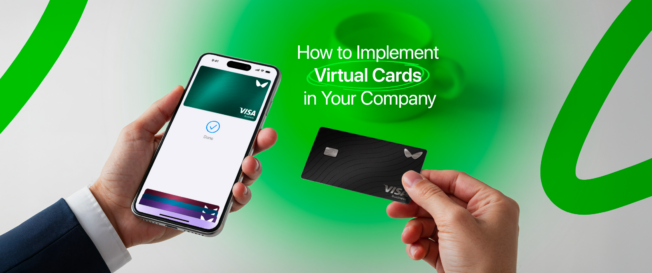More businesses are moving away from traditional payment methods and looking for smarter ways to manage how they pay and get paid. Virtual cards are becoming a popular choice, offering better control, stronger security, and faster payments. Whether you’re new to the concept or ready to start using them, this guide covers everything you need to know – from how virtual cards work to how to choose the right provider and set them up in your existing systems.
What is a virtual card?
A virtual card is a digital payment method that creates unique numbers for online transactions, without the need for a physical counterpart. Unlike traditional plastic options, these exist entirely in digital form and can be issued instantly through your bank or provider’s platform. Each number includes its own security code, expiration date, and usage window, which provides a highly secure tool for business payments.
These digital payment numbers are linked to your company’s main funding account. When it’s time to pay, the system creates a new set of credentials that can be used either once or with a specific merchant. The entire process takes just seconds, so you can issue payment credentials on demand, with no delays or need for plastic cards. The provider handles the technical side, while you stay in control of spending limits, usage restrictions, and approval rules.
One of the biggest benefits is the flexibility and speed of setup. Many companies find virtual payments offer clearer tracking and stronger reporting than traditional options. Every transaction generates detailed data that integrates directly with existing software, so reconciliation is far easier than sorting through paper cheques or juggling multiple corporate cards.
Further Reading: How Virtual Cards Work: The Technology Behind the Solution
How are virtual cards used?
Companies use virtual cards in a wide range of situations to simplify payments and keep a closer eye on spending. Some of the most common examples include paying vendors, covering travel costs, and managing subscriptions. When it’s time to pay a supplier or contractor, finance teams can generate a unique card number with a set spending limit and expiry date, adding a layer of control and reducing the risk of misuse.
Virtual cards are especially useful in B2B settings, where businesses often work with multiple suppliers. Instead of exposing details from a main company card, they can issue individual virtual cards tied to specific payment amounts and merchant categories. This method lowers the risk of fraud and helps track exactly where the money is going – whether it’s for a particular team, project, or department.
For marketing and advertising teams, virtual cards offer an easy way to manage campaign budgets across multiple platforms. Each campaign or channel can have its own dedicated card, helping track ROI more accurately and reduce overspend.
In many cases, virtual cards are used alongside enterprise resource planning systems. When an invoice comes in, the system can automatically create a card, make the payment, and update the accounts payable records. This reduces manual effort and frees up time for finance teams to focus on more important work.
How secure are virtual cards?
Security is one of the key reasons many businesses choose virtual cards over traditional payment methods. Each card number is unique and often set up for single use or limited use, which makes it extremely difficult for fraudsters to take advantage of compromised details. Even if someone manages to intercept a number, they won’t be able to use it beyond its set limits or after it expires.
Virtual cards come with several built-in security features that protect each transaction:
- Unique card numbers. Every payment is made with a different number, which removes the risk of repeat fraud.
- Spending controls. Limits can be set to block unauthorised purchases above a certain amount.
- Merchant restrictions. Cards can be restricted to specific suppliers or categories of merchants.
- Time-based controls. Expiry dates are applied automatically, keeping the window for misuse very short.
Banks and card providers back these features with real-time monitoring tools that check each transaction as it happens. If something doesn’t look right, the system can quickly flag or block the payment before any damage is done. This level of responsiveness goes well beyond what’s usually possible with physical credit cards, where a single compromised number can cause significant loss before anyone notices.
Additional options such as location limits and usage types provide even more control. This combination of settings gives businesses a much clearer view of how money moves through their systems, which is especially useful in industries that deal with sensitive payments or have strict compliance standards.
Further Reading: Virtual Card Fraud Prevention: How Secure Are They?
What are the differences between virtual cards and traditional payment cards?
The main difference between virtual and traditional payment cards comes down to how they work and how they are managed. Physical cards need to be manufactured, shipped, and replaced if lost or stolen. Virtual cards, on the other hand, are created instantly and exist entirely online. This removes the delays and logistics that come with managing plastic cards.
How each type is processed also varies. Physical card payments often rely on manual input or card readers, which can slow things down. Virtual cards are processed digitally – perfect for businesses that use automated systems for reconciliation and approvals.
Costs are another point of contrast. With physical cards, businesses pay for production, delivery, and replacements. Virtual cards remove these costs and often come with better rebate opportunities, especially when used at scale with key suppliers.
Control is where virtual cards stand out most. While traditional cards offer only basic limits and require manual oversight, virtual options let businesses control each transaction, from setting budgets to restricting usage by a merchant or expiry date.
| Feature | Traditional cards | Virtual cards |
| Form | Physical plastic | Digital only |
| Issuance | Requires production and shipping | Created instantly on-demand |
| Payment processing | Manual or via card readers | Fully digital, ideal for automation |
| Cost | Production, shipping, replacement fees | No physical costs; better rebate potential |
| Available controls | Basic spending limits | Customisable per transaction (amount, time, merchant) |
| Security | Vulnerable if lost or stolen | Single-use, time-limited, and locked to specific rules |
If you’re deciding between the two options, this detailed comparison of virtual and physical cards breaks down the pros and cons to help you choose what fits your business best.
Benefits of virtual cards
Introducing virtual cards into your payment setup brings a range of benefits that can change how your business handles spending. One of the biggest advantages is the increased control over company finances. Finance teams can apply specific limits to each transaction and set rules that align with internal policies. This kind of control helps keep budgets on track and reduces the time spent managing exceptions or fixing errors.
Faster processing is another key gain. Unlike paper cheques, which can take days or even weeks to clear, virtual card payments are processed instantly. This gives finance teams real-time visibility into what’s been paid, what’s still outstanding, and how that affects working capital. With clearer insight into cash flow, businesses are in a better position to make timely, informed decisions.
There are also meaningful efficiency improvements:
- Automated reconciliation. Transaction data flows directly into your accounting system, removing the need for manual entry.
- Instant issuance. Cards can be created on the spot, with no delays or physical delivery required.
- Faster approval workflows. Digital approvals replace paper trails, speeding up internal processes.
- Integrated reporting. Detailed transaction data helps with analysis, forecasting, and financial planning.
Security is another strong point. The use of unique card numbers, fixed spending caps, and merchant-specific settings provides a level of protection that traditional payment methods simply don’t offer. This makes virtual cards especially valuable for businesses that handle a high volume of supplier payments or operate in sectors where fraud risk is a serious concern.
Drawbacks of virtual cards
While virtual cards offer plenty of advantages, there are a few limitations that businesses should be aware of before getting started. One of the most common challenges is acceptance. Not every supplier is set up to take virtual card payments, and some still prefer traditional methods like paper cheques or bank transfers. This can cause complications, especially if you’re working with a mix of payment preferences across your vendor base.
Technology can also be a hurdle. Virtual card systems rely on stable internet access and compatible software, so companies using older systems may need to upgrade before they can make full use of the features. For some, this means extra time and investment at the beginning of the process.
Another point to consider is team training. Staff will need to learn how to issue, manage, and reconcile virtual cards as part of their day-to-day work. That learning curve can slow things down at first, particularly if the team is used to more traditional processes.
Costs can vary depending on the provider and how often you use the service. Although virtual cards remove expenses tied to physical cards, there may be processing fees, subscription costs, or minimum usage thresholds. These might be less appealing for smaller companies or those with inconsistent payment volumes.
Further Reading: The Complete Guide to Virtual Cards for Business
Reducing the cost and labour associated with accepting virtual cards
Businesses can cut both costs and manual effort by setting up virtual card acceptance in a way that fits smoothly into their existing systems. The key is integration. When virtual card payments are linked to accounting and procurement tools, they become part of an automated process that reduces the need for staff to manually enter payment details or chase reconciliation tasks.
Automation plays a big role here, especially in areas like invoice handling and expense tracking. By linking card transactions directly to purchase orders and invoices, companies can build a system that processes payments from start to finish with little human input. This also reduces errors and speeds up the entire workflow.
Getting suppliers on board is another way to improve efficiency. A good onboarding programme can encourage more vendors to accept virtual card payments, which helps simplify your payment setup. Instead of juggling several payment methods, you can centralise most of your outgoing payments through a single process.
Setting up proper spend controls from the beginning is just as important. Clear spending limits, merchant restrictions, and approval steps help avoid costly mistakes and reduce the need for ongoing checks. With the right structure in place, the system runs on its own – making payments easier to manage and much less dependent on constant oversight.
Automated processing of credit card payments with virtual cards
One of the strongest advantages of using virtual cards is the ability to automate the entire payment process. The system can generate virtual card numbers automatically as soon as a purchase order is approved. This removes the delays tied to manual card creation and physical distribution. With instant issuance, payments can be processed right away, while businesses maintain full control over how each card is used.
When virtual cards are connected to existing systems, they open up a wide range of automation possibilities that extend past basic transactions. For example, if card data feeds into an expense management platform, the system can categorise each payment, apply the correct cost centre codes, and produce detailed reports for finance teams. This helps save time and improves accuracy across the board.
Accounts payable processes also benefit from this automation. Instead of matching invoices to payments manually, the system can automatically connect virtual card transactions with their corresponding purchase orders. This gives businesses a much clearer picture of cash flow and reduces the time needed to complete month-end tasks.
Real-time transaction monitoring adds another layer of control. The system can flag potential issues as they arise. Alerts can notify team members when a transaction is declined, when a spending limit is close to being reached, or when activity looks out of the ordinary. This allows finance teams to respond quickly and keep the payment process running smoothly.

What are the ways businesses can integrate virtual cards into their systems?
Setting up virtual card integration is an important step toward making everyday payment processes faster, more accurate, and easier to manage. Depending on your existing systems and how complex your workflows are, there are several ways to approach it.
Here are the main integration options businesses can consider:
- Direct API integration. This is the most comprehensive solution. It links your virtual card provider directly to your enterprise resource planning (ERP) system. Payments, approvals, and record updates all happen automatically, with minimal manual processes. It’s ideal for businesses that want to automate at scale.
- Custom software integration. For companies with specific internal processes, integrations can be tailored to match. For instance, when a purchase order is approved, the system can automatically generate a virtual card, apply a spending limit based on the order amount, and restrict the card to a specific supplier. This helps maintain your existing workflow while adding more control and transparency.
- Cloud-based platforms. These tools offer a flexible alternative if you’re not ready for a full API integration. They connect with your accounting software using simple data import/export methods or web interfaces. While not fully automated, they still reduce manual effort and are easy to set up.
- Mobile apps and digital wallets. These are especially useful for teams working remotely or travelling. Authorised employees can issue and use virtual cards from their devices while staying within company policy and approval rules. It’s a practical option for field-based roles and decentralised teams.
The final choice depends on how your business operates day to day, but all these options help simplify payment processes and give you greater control over how company money is spent.
Choosing the right virtual card provider
Choosing a virtual card provider takes more than comparing features. The platform should fit your current systems, match how your business operates, and support you as your needs grow. A provider that’s easy to work with from the start can make the entire process smoother and more efficient.
Start with technical compatibility. The provider should offer clear integration options that work well with your accounting and procurement tools. Look for those that offer reliable API connections, straightforward data exchange, and reporting tools that support day-to-day financial tasks.
Security and compliance should also be part of your decision-making. The issuing bank behind the programme should be financially stable and meet all regulatory requirements. On the technology side, the platform should offer tools that help protect against fraud, including transaction monitoring, user controls, and secure data handling.
Pricing needs to be clear and predictable. Look at more than just transaction fees. Check for setup charges, monthly fees, and any other service costs that might apply. Think about how the pricing might change with your payment volume and whether the provider offers better terms as your usage increases.
Customer support is also worth attention. Good service can save a lot of time during setup and when questions come up later. Pay attention to support hours, response times, and whether you’ll have access to someone who knows your account. Training materials and guidance during the rollout can also help your team adapt faster.
Here are a few key things to look at when comparing providers:
- Integration – API access, system compatibility, and reliable technical support.
- Security – tools to detect fraud, meet compliance standards, and handle data safely.
- Pricing – transparent fees with no unexpected charges or unclear terms.
- Support – responsive service, onboarding help, and useful training resources.
Further Reading: 7 Must-Have Features in a Virtual Card Platform for Agencies
Getting a virtual business card
Applying for virtual business cards is now quicker and more straightforward than it used to be. As more companies adopt digital payment tools, financial institutions have simplified their onboarding processes to meet this growing demand. Most banks and specialist providers can set up business programmes in a matter of days, not weeks.
The application asks for basic company details, such as registration documents, financial history, and information about authorised users. Many businesses find it helpful to start with their current bank, as existing relationships can speed up the process and make integration easier. Approval usually depends on your company’s financial health. While some providers stick to traditional credit assessments, others take a broader view, factoring in your cash flow, transaction history, and day-to-day banking activity. This gives smaller or newer businesses a better chance of qualifying.
Once approved, the time it takes to go live depends on how complex your setup is. Simple virtual card programmes can often be activated in less than 48 hours. Larger setups with custom integrations or specific workflow requirements might take a few weeks, especially if your systems need configuration or testing.
Most providers offer onboarding support to help your team get started. This includes training, setting up card controls, and deciding on spending limits and approval rules. Getting these steps right at the beginning saves time later and helps prevent errors or misuse.
👉 Learn more about setting up virtual cards with Wallester Business
Steps to get started with a virtual business card programme:
- Choose a provider
Compare banks and virtual card platforms based on features, support, and compatibility with your current systems. - Submit your application
Prepare key documents such as business registration certificates, bank statements, and authorised user details. - Undergo assessment
Providers will evaluate your company’s financial profile, including revenue, cash flow, and transaction volume. - Get approved
Depending on the provider, approval can take anywhere from a few hours to several days. - Configure your setup
Define user roles, set spending limits, and connect the system to your accounting tools if needed. - Train your team
Use the training materials or onboarding support offered by your provider to educate your staff on best practices. - Start issuing virtual cards
Once your setup is complete, you can begin creating cards and making payments right away.
Effortless implementation of virtual cards in your business with Wallester
Wallester Business offers a powerful virtual card platform tailored for companies that want more control, speed, and visibility in their payment processes. With the ability to issue virtual Visa cards instantly, businesses can set detailed parameters for each card, including limits, merchant access, and expiration dates, all managed from a single interface.
The platform connects smoothly with existing systems through a well-documented API, making integration with accounting or ERP tools straightforward. This allows for real-time synchronisation of payments and automated reconciliation, cutting down on manual work and improving data accuracy.
Wallester is built with usability in mind. Teams can start issuing and managing virtual cards shortly after onboarding, without complex setup procedures. The system provides rich transaction data, helping finance teams track spending in detail and match payments to specific purchases or departments.
Security is central to the platform’s infrastructure. Every transaction is monitored in real time, with automatic alerts for unusual activity. Businesses can choose between single-use or reusable virtual cards depending on the payment scenario, adding flexibility without compromising control.
The pricing model is transparent and scalable. There are no hidden fees, and businesses only pay for what they use. Whether you’re managing subscriptions, supplier payments, or employee expenses, Wallester makes it easy to modernise your payment infrastructure with minimal disruption and strong support at every step.To learn more about setting up virtual cards tailored to your business needs, visit the Wallester Business platform. It offers instant issuance, flexible spending controls, and seamless integration with your existing financial systems.


